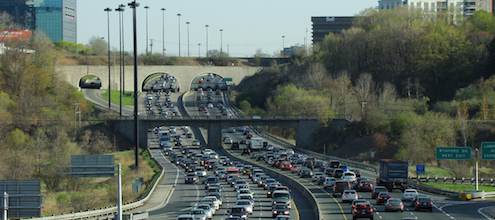
Think big, start small: Eliminating traffic in Canada’s biggest cities by putting a price on it
Imagine your daily commute with no traffic. Cars, buses, and trucks still fill the roads, but everyone is moving at speed. Instead of taking half-an-hour to get to school, the office, or worksite, you get there in a cool 10 minutes. Your coffee or tea is still piping hot when you arrive.
This future is unthinkable for many Canadians. Traffic in cities like Vancouver, Toronto, and Montreal is bad and is getting worse. But there is a solution. Congestion pricing can help cut traffic and return a sense of sanity and consistency to our daily travels. It’s time to think big and give congestion pricing a chance. Pilot projects are a good place to start.
Congestion does more than infuriate
Traffic is an ugly side of progress. Canadian cities are engines of economic growth and prosperity. But as cities get bigger and denser, our roads are getting more choked. Traffic wastes our time and money. It stresses us out. It reduces how much time we have for family, exercise, and rest. In an age of political polarization, our shared disdain for gridlock unites us all.
And it’s not just commuters in their personal vehicles feeling the pinch. Clotted streets slow down buses, make transit less reliable and predictable, and delay the trucks that keep our economy moving. The clothes on our back, the food in our fridge, even the gasoline in our car—it’s all delivered by truck. Congestion is a hidden tax on everything. We all pay the price.
Traffic also fills our lungs and warms the planet. Vehicles release far more pollution at stop-and-go speeds, which dramatically increases health risks for the 12 million Canadians that live near major roadways (particularly for children and the elderly). It also means more greenhouse gas emissions that contribute to climate change.
Put a price on it
Although it may seem like an obvious fix, building bigger and wider roads is not the answer. More road space invites more drivers onto the road. It subsidizes sprawl and makes people even more reliant on inefficient, low-occupancy travel. The proposed highway west of Toronto is the latest iteration of this wishful thinking. Improving public transit also has limits with how many people it can get off the roads (see this modelling done in Vancouver, page C-5).
The only long-term fix for congestion is to put a price on it. Pricing our roads, highways, and bridges provides a powerful incentive for people to travel at off-peak times or by other means. It works best when drivers are charged higher fees during peak periods and low (or no) fees during off-peak periods. It’s the polluter-pay principle for drivers.
Critically, congestion pricing doesn’t require everyone to change their driving habits to be effective. In Stockholm, for example, congestion pricing encouraged 20% of road users to not drive at peak times, which reduced congestion by 30% to 50%. Commute times are more reliable, despite a growing population. Air quality has improved and GHG emissions have dropped by 14%. The city also raises over $200 million in (net) revenues each year, which it ploughs back into the transportation system.
Piloting pilots
Despite the evidence, congestion pricing in Canada is still just an idea. The issue is simmering in Metro Vancouver after an independent commission recommended congestion pricing as a way to help a region quickly running out of space. Toronto came close to tolling the Gardiner Expressway and Don Valley Parkway in 2016 before the idea was ultimately quashed by the province. Montreal has considered tolling its bridges on multiple occasions, but has never followed through.
So, what’s the trick to unlocking gridlock in Canada’s major cities? In two words: pilot projects.
Canadians are understandably skeptical that paying tolls will result in smoother, faster commutes. Pilot projects can allow drivers to see and feel the benefits first-hand. In Stockholm, the level of public support for congestion pricing flipped: from 60% opposition prior to their pilot project to nearly 70% support after the program was up and running.
This isn’t to say that pilots are easy. Transportation planning in Canada is messy. Roads, bridges, and highways cross municipal boundaries, and provinces and the federal government wield lots of control. To get buy-in, it may help to start small. The City of Vancouver, for example, could implement a pilot project within its own jurisdiction to show the other 20 regional municipalities what congestion pricing can do.
It’s time to give congestion pricing a chance
It’s easy to dismiss congestion pricing as something we can’t afford. But if we ever want to unlock our city streets from the perils of traffic, we must be bolder and give congestion pricing a chance. A traffic-free commute may sound like an impossible dream, but it’s well within reach. Cities can start with pilot projects.
Next time you find yourself sitting in traffic, ask yourself: would you be willing to pay a dollar or two to be home by now? Seems like a small price to pay for what we can get in return.




1 comment
This would be such a good way to reduce the engine size of people’s daily commute. It could be priced to increase the adoption of low and zero emission vehicles especially delivery vehicles.
Comments are closed.